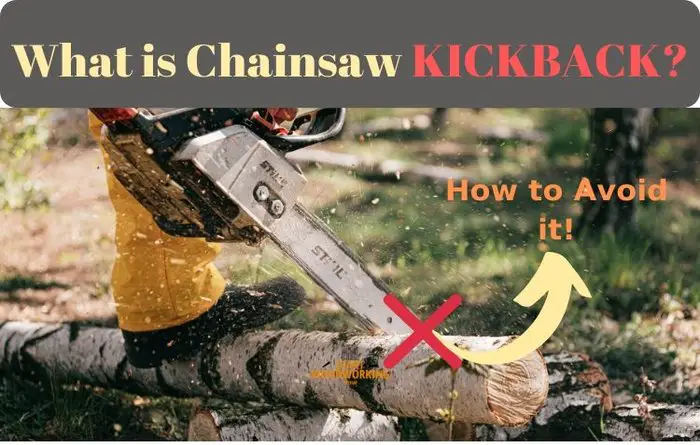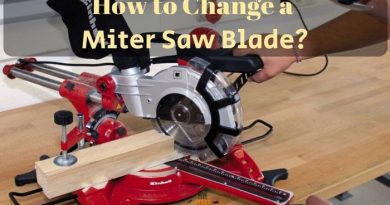What is Chainsaw Kickback? How to Avoid it!
One of the most common reasons for chainsaw accidents is a chainsaw kickback. We need to see what is a chainsaw kickback and how to avoid it.
Chainsaw kickback is a term used to describe the sudden upward movement of a chainsaw’s guide bar. The phenomenon of kickback, occurs when the nose of the chainsaw guide bar hits an object or becomes jammed in the cut.
What is Chainsaw Kickback?
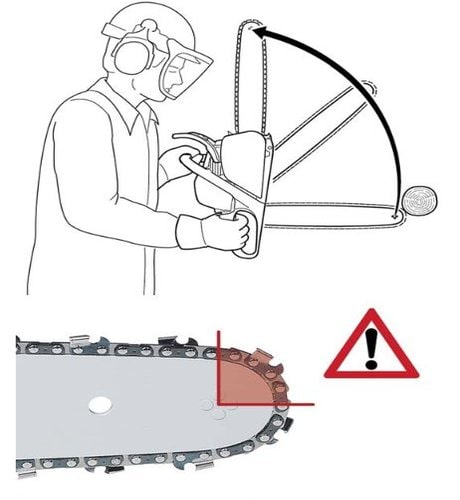
A kickback occurs if the rotating chain at the tip of the guide bar comes into contact with an object or if the chain gets stuck in the wood during sawing.
This contact of the guide bar tip can in some cases lead to a lightning-like reversal reaction and throw the guide bar up and back towards the operator.
Pinching the saw chain in the upper area of the guide bar can cause the guide bar to kickback violently in the direction of the operator. In either case, you can lose control of the chainsaw and seriously injure yourself and others around you.
Touching the tip of the bar can sometimes lead to an unexpected reaction, in which the guide bar is knocked up and towards the operator.
Jamming the saw chain on the upper edge of the guide bar can push the bar violently back in the direction of the operator.
What is the kickback zone?
The tip of a chainsaw’s guide bar is also known as the KICKBACK ZONE . If there is contact with an object such as a branch or tree trunk, there is a risk of a sudden kickback reaction of the guide bar tip.
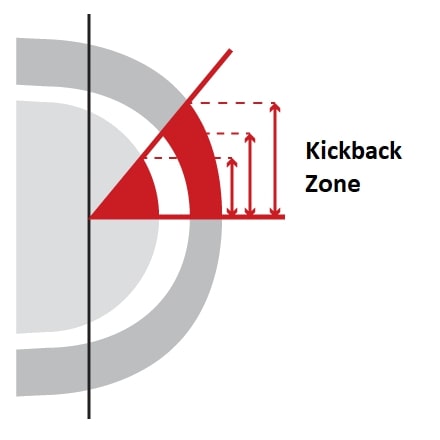
If you place the chainsaw bar in the upper half of the bar tip, the so-called kickback zone, the guide bar tip is pulled up and the saw is thrown towards the face by the force of the rotating chain – it takes little imagination to imagine how dangerous such a setback can be.
Modern chainsaws are equipped with a multitude of safety mechanism to reduce the risk of injury from kickback or other causes.
These include the chain brake, the front hand guard , the tip of the guide bar as well as zero or reduced rebound chains and guide bars.
In order to guarantee the protection of these devices, it is important that your chainsaw is properly and fully assembled and that all components are securely attached and functional.
What causes chainsaw kickback?
There are two circumstances that can cause chainsaw kickback:
- The first occurs when the moving chain at the end or nose of the guide bar hits an object.
- The second occurs when the wood closes, trapping the chain saw in the middle of the cut.
These two situations cause the chain guide of the chainsaw to be thrown up and back of the chainsaw ‘(or “kickback”), which could cause the user to lose control of the saw, possibly leading to injury to himself or others.
The following factors (alone or in combination) can increase the risk of a chainsaw kickback:
- Poor saw maintenance
- Blunt chain
- Chainsaw chain tension too low
- Incorrectly installed chain parts
- Loose rivets
- Bent, cracked or broken chainsaw chain components
- Poorly sharpened chain angles
- Excessive chain depth guide gauge settings
- Incorrect chain depth guide shapes
How to avoid chainsaw kickback?
Tips to avoid chainsaw kickback
The best protection to avoid being injured by a chainsaw kickback is to avoid situations where there is a risk of kickback:
- Take the chainsaw with both hands and hold it firmly.
- Always observe the head of the guide.
- Take care that the guide head never touches any object. Do not cut branches with the guide bar head. Carefully cut small hard branches, undergrowth and shoots, as the chain can easily get caught.
- Do not lean too far forward.
- Do not saw with raised arms.
- Attack the cut at full speed(throttle).
- Cut only one trunk at a time.
- Be extremely careful when inserting the chainsaw into a cut that has already started.
- Do not attempt to mortise without being familiar with this working technique.
- Never forget that the trunk can change position and that various forces can close the cutting slot and jam the chain.
- Only work with a chain in good condition, properly sharpened and well tensioned.
- Stand sideways with respect to the cutting plane of the chainsaw.
Kickback awareness
Be constantly ready to react to the backlash and aware of your position with respect to the tip.
There are different models of chains available for every cutting need. Within the range of models suitable for your needs, choose the one with the lowest risk of kickback.
Narrow-tip bars, provide more guarantees with regard to limiting kickback.
Wear Protective Equipment And Clothing
Always wear appropriate clothing, avoiding loose clothing in particular, which could hinder the operator or get caught, making work with the chainsaw difficult and dangerous:
- Protective helmet.
- Protective cap.
- Glasses or visor to protect the eyes.
- Protective gloves to allow a firmer grip.
- Heavy boots to protect feet and legs.
- Leg protection trousers.
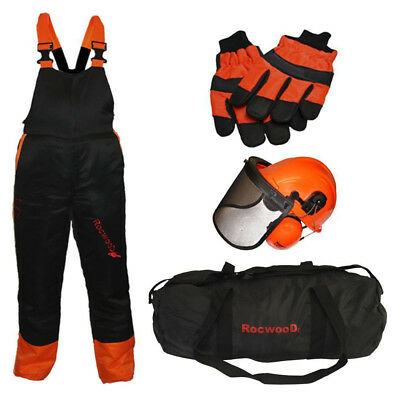
Precautions must obviously be taken to avoid injuries and accidents:
• The surprise effect plays a lot on the risk of accidents: the knowledge of this chainsaw kickback phenomenon and its understanding already make it possible to limit the risks of surprise and loss of control: it is therefore necessary to avoid touching the ground or an object with the guide bar nose.
• Using chainsaw with both hands : with one hand, the chainsaw control is greatly reduced . It may slip or slip, possibly causing accidents. To properly hold the chainsaw, the right hand is positioned on the rear handle and the left on the front handle . A firm grip avoids kickbacks and thus better handles the device. In addition, it should not be held at arm’s length or above the chest.
• Even if a high volume cut helps reduce the risk of kickback , if you are not comfortable using a chainsaw, choose low or medium revs . Indeed, the control will only be better, especially in delicate situations. A controlled grip of the device reduces the risk of rebounds.
• Also make sure to maintain the chainsaw regularly by carefully following the instructions provided in the user manual.
How do I stop my chainsaw kickback?
The most important device to reduce the risk of chainsaw kickback of such an injury is the chain brake. In the event of a kickback, it stops the chainsaw chain and engine in a split second and prevents it from running.
Check the chain brake functionality before you start working with the saw by doing the following:
- Place your chainsaw on a stable surface
- Start your chainsaw. Hold the chainsaw firmly.
- Press the gas at full throttle.
- Release the chain brake. Press against the hand guard with your left hand, your hand should remain on the handle. Then release the throttle.
- The chain must stop IMMEDIATELY, the same applies to the chainsaw engine. If the chainsaw cannot be release or if the chain or motor does not come to a standstill immediately, take your chainsaw to one of the chainsaw specialist.
- As a last step, check that the chain can be pulled over the guide bar by hand. If so don’t take any chances and take your chainsaw to one of the specialist
How to Reduce Chainsaw Kickback?
Now that you know what a chainsaw kickback is and how it can occur, it is time to know how to reduce chainsaw kickback:
- Before using a new chainsaw, be sure to read the operating instructions completely.
- When using a chainsaw, stay alert at all times.
- If you are tired, this is not the right time to use a chainsaw.
- Be especially careful when cutting tree branches.
- Bouncing can occur during limbing if the guide’s nose hits stumps, logs, hidden branches and the tip of the logs.
- When preparing a tree for felling, use the underside of the guide (also known as a pull chain).
- Never saw above shoulder height. Following these two practices will help reduce the risk of a chainsaw kickback when pruning trees and felling bushes and small trees blocking your path.
- If you are using your saw for felling or cross cutting, the best thing to do might be to push the chainsaw guide into the trunk.
- However, the best way to avoid chainsaw kickback is not to put the tip of the chain saw guide against the wood.
- Make sure the chain brake on your saw is working before use.
- Pay attention to the nose of your chain saw guide and its position.
- Choose low kickback saw chains.
- When purchasing a chainsaw chain, choose the one with the lowest kickback potential while meeting your needs.
- Use narrow nose guides, to maximize bounce safety.
Wear appropriate clothing and equipment to protect frequently injured areas:
- Leggings-apron for chainsaw
- Gloves
- Eye protection (either glasses security or a face shield)
- A helmet
- Hearing protection (i.e. ear muffs or ear plugs)
- Robust boots, like lumberjack boots
- Avoid clothing that is too tight or too loose.
- When cutting, make sure your thumbs and fingers are fully closed around the handles of your chainsaw.
- When servicing, follow all of the instructions that came with your chain saw chain.
What should you watch out for when cutting branches and undergrowth?
When cutting a branch that is under tension, expect that the chainsaw kickback. When the tension in the wood fibers is released, the tensioned branch can hit the operator and / or take the chainsaw out of control.
Be especially careful when cutting undergrowth and young trees. The thin tree can get caught in the saw chain and hit you or unbalance you.
Conclusion
Most modern chainsaws include features that reduce kickback and other causes of injury.
These built-in features include chain brakes, front hand protection (left), bar end protection, and low or reduced kickback chain and guide bar.
To ensure the effectiveness of these safety features, you must ensure that your chainsaw is properly assembled and that all components are properly secured and functional.
If you do not have the experience or training to react to the kickback of a chainsaw, you should use a low kickback chain. In North America, the low kickback chain is packed with a green label.
What are the chainsaw safety functions?
1. The anti-kickback device and the chain brake guarantee that the chain will stop if the chain saw is not handled correctly or if it rebounds
2. The throttle lock is designed to keep the chain saw running only if you hold down a given button
3. Chain sensor prevents chain from falling if chain breaks or derails
4.Right hand protection protects your right hand in the event of chain breakage or derailment
5. Easily accessible stop command lets you instantly stop the chain

